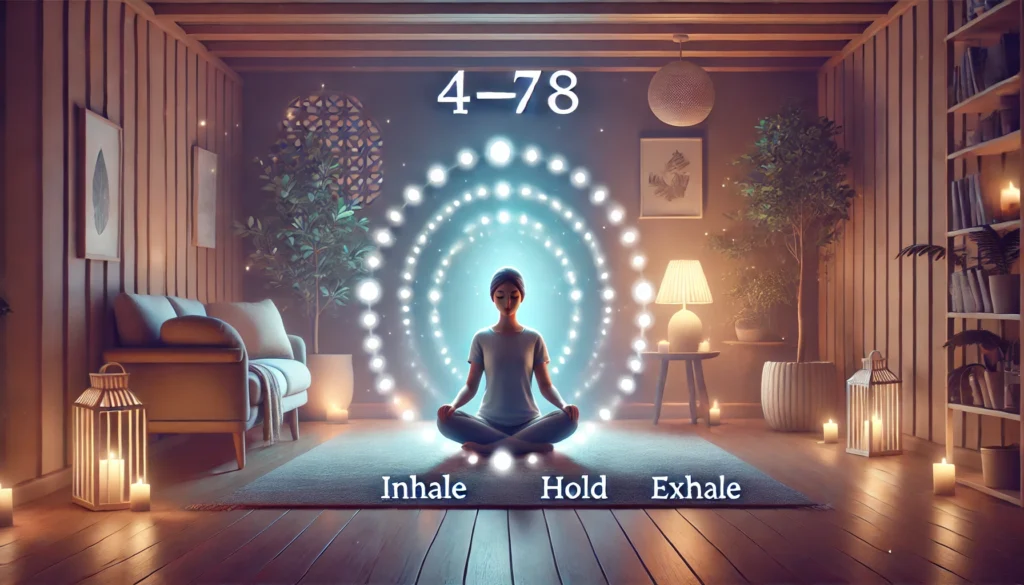Introduction
If you've ever felt the need to calm your mind, reduce stress, or improve your overall well-being, you might want to explore the ancient practice of 4-7-8 breathing technique. Rooted in the yogic tradition of pranayama, this breathing technique has gained popularity for its potential to alleviate anxiety and enhance mental clarity. The method involves a simple sequence: inhale for 4 seconds, hold your breath for 7 seconds, and exhale for 8 seconds.
But what sets 4-7-8 breathing apart? How does it work, and what are its proven benefits? In this deep dive, we'll unravel the science behind the technique and explore how incorporating it into your daily routine can lead to a calmer, more centered life.
Table of Contents
What Is the 4-7-8 Breathing Technique?
The 4-7-8 breathing technique, rooted in an ancient yogic method called pranayama, is a practice designed to provide control over one's breathing. Developed by Dr. Andrew Weil, this technique involves inhaling for 4 seconds, holding the breath for 7 seconds, and exhaling for 8 seconds. Regular practice may expedite the process of falling asleep for some individuals.
How Does the 4-7-8 Breathing Technique Work?
Breathing techniques, including the 4-7-8 method, induce deep relaxation by involving specific breath-holding patterns. This aids in oxygen replenishment throughout the body, from the lungs outward, offering a rejuvenating boost to organs and tissues. By mitigating the body's fight-or-flight response, this technique proves particularly beneficial for those grappling with sleeplessness due to anxiety or daily stressors.

The 4-7-8 technique shifts focus from intrusive thoughts to breath regulation, serving as a natural tranquilizer for the nervous system, according to Dr. Weil. Comparable to practices like alternate nostril breathing, mindfulness meditation, visualization, and guided imagery, it aims to soothe a racing heart and calm frazzled nerves.
Individuals experiencing mild sleep disturbances, anxiety, or stress may find 4-7-8 breathing instrumental in overcoming distractions and achieving a relaxed state. Proponents suggest that its efficacy intensifies with consistent practice, becoming a powerful tool for managing sleep-related issues.
How to Practice 4-7-8 Breathing
To engage in 4-7-8 breathing, find a comfortable seated or lying position. Ensure good posture, especially when starting. For those using the technique to induce sleep, lying down is preferable.
Initiate the practice by placing the tip of your tongue against the roof of your mouth, behind your top front teeth. Maintain this tongue position throughout the exercise. Some individuals find it helpful to purse their lips during exhalation.

Follow these steps within the cycle of one breath:
- Part your lips and exhale completely through your mouth, making a whooshing sound.
- Inhale silently through your nose, counting to four.
- Hold your breath for seven seconds.
- Exhale audibly for eight seconds.
Complete four full breaths initially, gradually increasing to eight breaths with continued practice. The seven-second breath-hold is pivotal, and practitioners are advised to avoid situations where immediate alertness is required post-practice.
Other Techniques to Enhance Sleep
While 4-7-8 breathing can be effective, combining it with other interventions may amplify its benefits. Consider incorporating:
- A sleeping mask
- A white noise machine
- Earplugs
- Relaxation music
- Essential oils diffusion, especially lavender
- Reduced caffeine intake
- Bedtime yoga
If 4-7-8 breathing proves insufficient, alternative techniques like mindfulness meditation or guided imagery may offer better results.
In cases of severe insomnia or underlying health issues contributing to sleep disturbances, seeking medical attention is crucial. Hormonal changes, medications, substance use disorders, mental health conditions, sleep apnea, pregnancy, restless leg syndrome, and autoimmune diseases can all impact sleep. Consult with a doctor or a sleep specialist for a comprehensive diagnosis and appropriate treatment.
Frequently Asked Questions
1. How often should I practice 4-7-8 breathing for optimal results?
- Start with at least twice daily, gradually increasing frequency based on individual comfort and experience.
2. Can 4-7-8 breathing be practiced in any setting?
- While it doesn't require a specific environment, it's best practiced in a relaxed setting, especially if used for sleep induction.
3. What if 4-7-8 breathing doesn't work for me?
- If this technique is ineffective, consider exploring alternatives such as mindfulness meditation or guided imagery. If sleep issues persist, consult a healthcare professional.
Conclusion
Incorporate the 4-7-8 breathing technique into your routine to harness its transformative benefits. From promoting relaxation to improving sleep, this ancient practice, curated by Dr. Andrew Weil, offers a holistic approach to well-being. Experiment with the technique and consider complementing it with additional relaxation tools for a comprehensive approach to a restful night's sleep.





[…] 4-7-8 Breathing: A Deep Dive into the Technique and Its Benefits […]